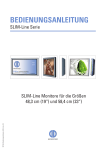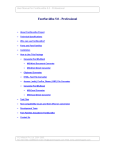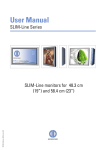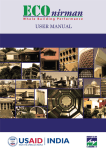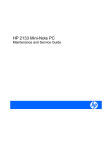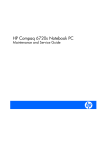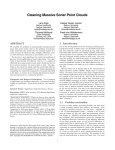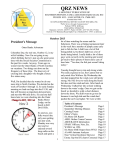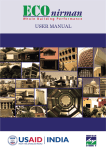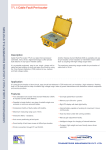Download User Manual - Moinee Systems
Transcript
ECObench USER MANUAL April 2014 ECObench User Manual Current Version: 2.0 Bureau of Energy Efficiency: Dr. Ajay Mathur, Sanjay Seth, Girja Shankar, Shammi Noor Shakti Sustainable Energy Foundation: Smita Chandiwala, Kunal Gupta ps Collective: Dr. Saket Sarraf, Shilpi Anand Saboo Moinee Systems: Arvind Thanvi, Vinay K Bissa Acknowledgment: This version of the user manual builds upon the work done under the USAID ECOIII Project with updated graphics reflecting changes in the new tool. Disclaimer: This initiative has been supported by Shakti Sustainable Energy Foundation. The views and analyses presented in this web tool do not necessarily reflect those of the Shakti Sustainable Energy Foundation. The Foundation accepts no liability for the content of this tool, or for the consequences of any actions taken on the basis of the information provided. Previous Version: 1.06 Bureau of Energy Efficiency: Dr. Ajay Mathur, Sanjay Seth, Shabnam Bassi, Girja Shankar, Brijesh Manan USAID India: Dr. Archana Walia International Resources Group, USAID ECO-III Project: Dr. Satish Kumar, Aalok Deshmukh, Bibhash Das, Madhav Kamath, Vikas Arora ps Collective: Dr. Saket Sarraf, Shilpi Anand Saboo Ride Softech Solutions LLP: Pallavi Phadke, Ninad Patil, Ishani Ranade, Sanket Lele Disclaimer: This version was made possible through the support of American people through United States Agency for International Development (USAID) under the terms of Award No. 386C-00-0600153-00. The contents of this web tool are the sole responsibility of International Resource Group (IRG) and do not reflect the views of USAID or the United States Government. How to use this manual The following symbols and icons are used in this user manual: The text underlined in blue colour is a cross-reference within the user manual itself. In the soft copy, click it to open the section that is cross-referenced. Table of Contents 1. Energy Benchmarking _________________________________________________ 1 2. ECObench Tool _______________________________________________________ 1 2.1 How to Access _________________________________________________________ 2 3. Homepage ____________________________________________________________ 3 3.1 Navigation Bar _________________________________________________________ 4 4. Benchmarking Tool ___________________________________________________ 5 4.1 User Inputs_____________________________________________________________ 6 4.2 Benchmarking Results __________________________________________________ 6 4.3 Energy Benchmarking Report __________________________________________ 10 5. Glossary of Acronyms _______________________________________________ 12 6. Appendix: Computer Settings _________________________________________ 13 1. Energy Benchmarking Buildings in India must continuously monitor and improve their performance for the country to transit to an energy efficient economy. It is important to measure this performance against the established benchmarks. The aim is to improve the design, construction, maintenance, and operation of buildings by measuring the energy performance against established benchmarks, and recognize and reward exemplary buildings. Energy benchmarking is a process of creating a whole building energy consumption profile of a group of buildings characterized by their primary use, construction, physical, geographic, and operating characteristics. The rating is derived by assigning a score to the performance differential between the building under consideration and a benchmarked building in relation to all other buildings in the stock. 2. ECObench Tool The Ministry of Power, Government of India, set up the Bureau of Energy Efficiency (BEE) under the provisions of the Energy Conservation Act, 2001. As one of its primary objectives, BEE has focused on efforts to reduce energy intensity of the Indian economy by reducing the wasteful use of energy and bridging the power demand-supply gap. It is with this in mind that BEE, with technical assistance from United States Agency for International Development (USAID) Energy Conservation and Commercialization-Phase III (ECO-III) Project and subsequently the Shakti Sustainable Energy Foundation, embarked on an initiative to evaluate building energy performance based on actual consumption and undertook the energy benchmarking initiative. Under the guidance of BEE, an online tool called ECObench was conceived and developed to benchmark and rate the energy performance of the commercial buildings. The ECObench Tool gathers inputs from the user to measure the performance of a building against its peers. It displays the benchmarking result in a graphic as well as tabular fashion for the convenience of the user. The tool also generates a report that may be submitted to the authority having jurisdiction to demonstrate a building’s performance. 1 ECObench Tool is an online energy benchmarking and rating tool provided by BEE. Building owners can use this tool to compare the energy performance of their buildings with that of its peers. In addition, the report that this tool generates may also be used to set targets for the building under consideration. ECObench is a web-based tool that is made available to the users over the Internet with minimal software requirements or building science expertise. It can be used with minimal learning involved. It keeps the information secure and confidential. It is available in the public domain (http://ECObench.eetools.in) for easy access to the users. 2.1 How to Access Enter the link http://ECObench.eetools.in in the web browser's address bar to access ECObench Tool. See Appendix for Computer Settings to learn about the settings required on a user’s computer before using the tool. 2 3. Homepage The following illustration highlights the composition of ECObench Tool home page. A B C Navigation Bar (see § 3.1) Direct Link to the benchmarking pages of Hospitals. (see § 4) Concepts related to energy benchmarking and performance rating tool 3 ECObench Tool is aesthetically designed, keeping in mind the ease of navigation for the enduser. It allows the user to provide inputs that do not need to be sequential. The information can be provided in the sequence preferred by the user. This makes it more intuitive and interactive. 3.1 Navigation Bar The navigation bar (as shown below) at the top right corner of the screen can be used to access the tool and acquire additional information on it. Home Click to view the home page of the tool (see § 3) Benchmark Click to select for hospital benchmarking (see § 4) Credits Click to view the tool version and credits Help Click to view Frequently asked questions (FAQs) and this user manual 4 4. Benchmarking Tool Energy benchmarking can be performed using ECObench Tool by clicking the “Benchmark Hospital" button on the homepage of the ECObench Tool. The following illustration highlights the composition of the benchmarking page. A Navigation Bar (see § 3.1) Benchmarking Report(see § 4.3) B Building related inputs for performing benchmarking (see § 4.1) C D Benchmarking results: Energy Performance Intensity (EPI) and building ranking and interpretation (see § 4.2) E Benchmarking results (charts): Performance distribution curve and histogram. (see § 4.2) F Benchmarking results: Star rating and performance bands for hospital buildings (see § 4.2) 5 4.1 User Inputs Enter building’s information such as its built-up area, electricity consumption details, and climate zone it is located in. It is important to provide correct inputs to get accurate benchmarking results. 4.2 Benchmarking Results Based on the inputs provided, the benchmarking results (which occupy the rest of the screen) get dynamically updated. The following sub-sections help in interpreting the results. A. Energy Performance Intensity (EPI) The Energy Performance Intensity (EPI) is defined as the annual energy consumption measured in kWh per square meter of the built-up area of the building. It is the ratio of the total energy used to the total built-up area and is expressed as kWh/m2/year. Alternatively, it is also defined as the annual energy consumption measured in kWh per bed in a hospital. 6 The parameters for the measured building are compared with the benchmark building in the national database. In the above example, the building that is being measured is consuming less energy and therefore performing better than the benchmark building. The benchmark building is modelled by applying a regression equation on the available data that is representative of energy consumption in buildings in the country. B. Building Rank The measured building's performance is ranked in percentile terms vis-à-vis all the other buildings of the same type in the database. The best performing building is ranked 1 and the worst one is ranked 100. 7 C. Charts The EPI and the performance rank are graphically displayed on the line chart. The performance band of the measured building is depicted on the histogram. The red markers on the two graphs show the building’s performance relative to all other buildings. The red marker on the performance distribution curve (first graph) shows its EPI (kWh/m2/year) measured on the left Y-axis and performance rank measured on the X-axis. The red curve is unique to every building. The enhancements in terms of building systems will enhance the performance and the building will slide up and down its own unique curve. The blue curve and the blue marker show the same information, but normalized by the use intensity rather than the built-up area (the number of beds in the above illustration). The histogram shows different EPI bands corresponding to different rating levels. The heights of these bands are specific to the building information entered by the user. 8 D. Star Rating / Performance Band The measured building is awarded a star rating/performance band based on its energy efficiency (EPI) as compared to that of its peers. The target energy performance for different ratings table provides reference points to achieve a different rating for the same building. Thus, a building with the characteristics entered by the user will have to consume 164 to 205 kWh/m2 of energy per year or alternatively, 6529 to 8194 kWh/bed annually to obtain a 4-star rating. The star ratings are assigned to hospital buildings depending upon their EPI. 9 4.3 Energy Benchmarking Report The energy benchmarking report can be used for analysis and improvement purposes. See §6 to understand the settings required on the computer to access the benchmarking report. Following are the steps to generate an energy benchmarking report: Access the tool by clicking the “Benchmark” button located at the top right corner of the screen Enter the relevant information for your building. Once the information is entered, the tool will automatically rank your building. Click on the “Generate Report” button located at the top right corner of the screen. A modal pop up box (as shown below) will appear. Enter the information in pop-up box appropriately and click on “Create”. The report will be downloaded automatically. 10 The following is the composition of the energy benchmarking report: Report Section Details Captured Input Summary Comparison with national benchmark Evaluation Summary of the inputs provided by the user Energy comparison with the national benchmark building available in the national database EPI details of the building vis-à-vis the buildings in the national database Targets Various targets for the star ratings assigned to the buildings Remarks Remarks related to the building energy benchmarking exercise Certification Certification provided by the Authority Having Jurisdiction Disclaimer Disclaimer related to the building energy benchmarking result 11 5. Glossary of Acronyms Term Description BEE Bureau of Energy Efficiency EPI Energy Performance Intensity kWh Kilowatt Hour m2 Square Meter PDF Portable Document Format 12 6. Appendix: Computer Settings ECObench Tool is a web based application. No special software is required to be installed on the computer. Following are the system settings and recommendations for using the tool: ECObench Tool works with the latest version of all the popular web browsers. The HTML5 supported browser should be installed on the computer. For example download the latest Google Chrome Browser from https://www.google.com/intl/en/chrome/browser/ (consult the System Administrator for assistance, if required). No special plug-in or software is required to use the tool. JavaScript must be enabled in the web browser. The tool is best viewed in 1024 x 768 or higher screen resolution. PDF viewer must be installed on the computer to view the reports. e.g. Adobe® Reader® can be downloaded free of cost from http://get.adobe.com/reader Consult the System Administrator for assistance, if required 13 This page is intentionally left blank ABOUT SHAKTI SUSTAINABLE ENERGY FOUNDATION Shakti Sustainable Energy Foundation works to strengthen the energy security of India by aiding the design and implementation of policies that support energy efficiency and renewable energy.























